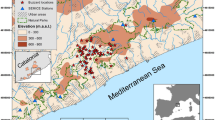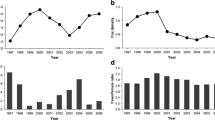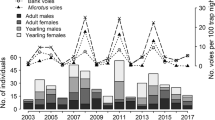Summary
We tested the hypothesis that synchronous fluctuations in small game species in boreal Fennoscandia are caused by varying predation pressure. The main prey of predators are the cyclically superabundant voles. Small game species (alternative prey) are rare compared to voles. The following 4 predictions were checked: (1) Predators should shift their diet from main prey to alternative prey as main prey decline. — This was confirmed using data on red fox (Vulpes vulpes L.) diet.; (2) The mortality rate of alternative prey should be inversely correlated to the abundance of main prey. — This was true for mountain hare (Lepus timidus L.) mortality rates and the rate of nest predation on black grouse (Tetrao tetrix L.).; (3) The total consumption of prey by all the predators should at least equal the critical losses in alternative prey during a decline year. — A tentative estimate of predator consumption amounted to 10 times the losses in grouse and hare.; and (4) The absence of synchrony between the species in the boreonemoral region should be associated with a more diverse diet of predators. — This was the case for red fox diets throughout Sweden. Although all 4 predictions were confirmed, we could not necessarily exclude other hypotheses involving changes in quality or quantity of plant food.
Similar content being viewed by others
References
Ahlmann HW (1976) Norden i text och kartor. Generalstabens litografiska anstalts förlag, Stockholm
Angelstam P (1983) Population dynamics of tetraonids, especially the black grouse Tetrao tetrix L., in boreal forests. Unpublished Ph D Thesis, Uppsala University
Angelstam P, Lindström E, Widén P Synchronous short-term population fluctuations of some birds and mammals in Fennoscandia — occurrence and distribution. Holarctic Ecology 8 (in press)
Angerbjörn A (1981) Winterfood as a limiting factor of dense mountain hare populations on islands — a comparative study. Proc World Lagomorph Conf, Guelph 1979, pp 529–535
Cabot WB (1912) In northern Labrador. J Murray, London
Cartwright BW (1943) The “crash” decline in sharp-tailed grouse and hungarian partridge in western Canada and the role of the predator. 9th N Am Wildl Conf, pp 324–330
Danell K (1978) Population dynamics of the muskrat in a shallow Swedish lake. J Anim Ecol 47:697–709
De Jounge J (1981) Predation of the pine marten (Martes martes L) in relation to habitat selection and food abundance during winter in central Sweden. Swedish Environmental Protection Board, Report 1401
Dunn E (1977) Predation by weasels on breeding tits in relation to density of rodents. J Anim Ecol 46:633–652
Englund J (1965) Studies on food ecology of the red fox (Vulpes vulpes) in Sweden. Viltrevy 3:377–485
Ericson L (1977) The influence of voles and lemmings on the vegetation in a coniferous forest during a 4-year period in northern Sweden. Wahlenbergia 4:1–114
Erlinge S, Göransson G, Högstedt G, Liberg O, Nilsson I, Nilsson T, v Schantz T, Sylvén M (1983) Predation regulating small rodent populations in Sweden. Oikos 40:36–52
Errington PL (1946) Predation and vertebrate populations (concluded). Quart Rev Biol 21:221–245
Formozow AN (1935) Fluctuations in the numbers of economically exploited animals. All-Union Cooperative Unified Publishing House, Moscow and Leningrad, (Translation by Jackson JD, for bureau of Animal Population, Oxford University, England)
Goszczyński J (1974) Studies on the food of foxes, Acta Theriol 19:1–18
Goszczyński J, Ryszkowski L, Truszkowski J (1976) The role of the european hare in the diet of predators in cultivated field systems. In: Pielowski Z, Pucek Z (eds) Ecology and management of European hare populations, Warszawa
Haftorn S (1971) Norges Fugler. Universitetsforlaget, Oslo
Hagen Y (1952) Rovfuglene og viltpleien. Gyldendal Norsk forlag, Oslo
Hansson L (1979) Food as a limiting factor for small rodent numbers — test of two hypotheses. Oecologia (Berlin) 37:297–314
Harper J (1977) Population ecology of plants. Academic Press, London
Haukioja E, Kapiainen K, Niemelä P, Tuomi J (1983) Plant availability hypothesis and other explanations of herbivore cycles: complementary or exclusive alternatives? Oikos 40:419–432
Höglund N (1964) Über die Ernährung des Habichts (Accipiter gentilis Lin) in Schweden. Viltrevy 2:271–328
Jenkins D, Watson A, Miller GR (1963) Population studies of red grouse (Lagopus lagopus scoticus (Lath.)) in north east Scotland. J Anim Ecol 32:317–376
Jokinen M, Häkkinen I (1982) On the population dynamics of the mountain hare (Lepus timidus) in the outer archipelago of SW Finland. Soumen Riista 29:66–75
Kaasa J (1959) En undersøkelse over naeringen hos orrfugler (Lyrurus tetrix L.) i Norge. Meddelser fra Statens viltundersøkelser 2(4)
Kalela O (1949) Über Fjeldlemming-Invasionen und andere irreguläre Tierwanderungen. Ann Zool Soc “Vanamo” 13:1–90
Keith LB (1974) Some features of population dynamics in mammals. 11th Int Congr Game Biol, pp 17–58
Keith LB (1983) Role of food in hare population cycles. Oikos 40:385–395
Lack D (1954) The natural regulation of animal numbers. Oxford University Press, London
Lasiewski RC, Dawson WR (1967) The re-examination of the relation between standard metabolic rate and body weight in birds. Condor 69:13–23
Lindén H, Rajala P (1981) Fluctuations and long-term trends in the relative densities of tetraonid populations in Finland, 1964–1977. Finnish Game Research 39:13–34
Lindlöf B, Lemnell PA (1981) Differences in island and mainland populations of mountain hare. Proc of World Lagomorph Conf, Guelph 1979, pp 478–485
Lindlöf B, Lindström E, Pehrson Å (1974) On activity, habitat selection and diet of the mountain hare (Lepus timidus L) in winter. Swedish Wildlife 9:27–43
Lindström E (1982) Population ecology of the red fox (Vulpes vulpes L) in relation to food supply. Ph D Thesis, University of Stockholm
Lindström E, Poulsen O, v Schantz T (1982) Spacing of the red fox (Vulpes vulpes L) in relation to food supply. In: Lindström E (ed) Population ecology of the red fox (Vulpes vulpes L) in relation to food supply. Ph D Thesis, University of Stockholm
Lockie JD (1959) The estimation of the food of foxes. J Wildl Manage 23:224–227
Lundberg A, Mattsson R, Nilsson B, Widén P (1980) Nötskrikans, Garrulus glandarius, beståndsstorlek under hösten i ett mellansvenskt barrskogsområde. Vår Fågelvärld 39:225–230
Marcström V, Höglund N (1980) Reproduction of willow grouse (Lagopus lagopus) in two high land areas in Sweden. Swedish Wildlife Research 11:185–314
McGowan JD (1969) Starvation of Alaskan ruffed and sharp-tailed Grouse caused by icing. Auk 86:142–143
Moors PJ (1982) Predation by stoats (Mustela erminea) and weasels (M. nivalis) on nests of forest birds in New Zealand. Third International Theriological Congress, Abstracts of Papers, p 163
Moss R, Watson A, Ollason J (1982) Animal population dynamics. Chapman and Hall, London
Myrberget S (1970) On the part played by predation in short-term variations in the population of willow grouse in Norway. Proc IXth Int Congr Game Biol, pp 458–464
Myrberget S, Olsvik Ø, Saether I (1981) On a “crash” in a population of Willow Grouse (Lagopus lagopus). Fauna Norv Ser C Cinclus 4:64–68
Novikov GA (1956) Carnivorous mammals of the fauna of the USSR. Israel program for Scientific Translations, Jerusalem
Olstad O (1932) Undersökelser over lirypens fortplantningsforhold. Statens Viltundersökelser, Medd 1:1–71
Ottosson I (1971) Något om skogshararnas inverkan på ön Jungfrun i Kalmarsund. Fauna och Flora 66:229–240
Pehrson O (1976) Duckling production of long-tailed duck in relation to spring weather and small rodent fluctuations. Unpublished Ph D Thesis, University of Gothenburg
Potts GR (1980) The effects of modern agriculture, nest predation and game management on the population ecology of partridges (Perdix perdix and Alectoris rufa). Adv Ecol Res 11:1–79
Pulliainen E (1981) Food and feeding habits of the pine marten in Finnish forest Lapland. Proc Worldwide Furbearer Conf, Frostburg 1980, pp 580–597
Pulliainen E (1982) Habitat selection and fluctuations in numbers in a population of the arctic hare (Lepus timidus) on a subarctic fell in Finnish Forest Lapland. Zeitschr Säugetierk 47:168–174
Sargeant AB (1978) Red fox prey demands and implications to prairie duck production. J Wildl Manage 42:520–527
Schmidt F (1943) Naturgeschichte des Baum und Steinmarders. Monographie der Wildsäugetiere 10:1–258
Semenow-Tjan-Sjanskij OI (1960) Die Ökologie der Birkhuhnvögel (Tetraoniden). Translation no 106, NFR, Stockholm
Shelford VE (1943) Abundance of the collared lemming in the Churchill area 1929–1940. Ecol 24:472–484
Siivonen L (1948) Structure of short-cyclic fluctuations in numbers of mammals and birds in the northern parts of the northern hemisphere. Papers on Game Research 1
Siivonen L (1954) On the short-term fluctuations in numbers of tetraonids. Papers on Game Research 13
Siivonen L (1957) the problem of the short-term fluctuations in numbers of tetraonids in Europe. Papers on Game Research 19
Sjörs H (1965) Forst regions. In: The plant cover of Sweden. Acta Phytogeographica Suecica 50, pp 48–63
Skoog P-A (1970) The food of the Swedish badger (Meles meles). Viltrevy 7:1–120
Statistical Abstract of Sweden (1970) Area and population of communes, Table 13
Statistical Abstract of Sweden (1971) Area, population, density of population, by county, table 10. Area and populations of communes, Table 63
Storaas T, Wegge P, Sonerud G (1982) Destruction des nids de grand tetras et cycle des petits rongeurs dans l'est de la Norvege. Actes du Colloque International sur le Grand Tetras (Tetrao urogallus major), Colmar 1981, pp 166–178
Suomos H (1952) Studies on the feeding habits of the common buzzard. Papers on Game Research 8:121–127
Tapper S (1979) The effect of fluctuating vole numbers (Microtus agrestis) on populations of weasel (Mustela nivalis) on farmland. J Anim Ecol 48:603–617
Varley GC, Gradwell GR (1960) Key factors in population studies. J Anim Ecol 29:399–401
Wikman M (1977) Duvkökspredation på skogsfågel i sydvästra Finland 1975–1976. Foredrag fra Nordisk Skogsfugel-symposium 1976. Direktoratet for vilt og ferskvannfisk, Viltrapport 5
Wildhagen A (1952) Om vekslingene i bestanden av smågnagere i Norge 1871–1949. Statens Viltundersökelser, Drammen
Wolff JO (1980) The role of habitat patchiness in the population dynamics of snowshoe hares. Ecol Monographs 50:111–130
Author information
Authors and Affiliations
Rights and permissions
About this article
Cite this article
Angelstam, P., Lindström, E. & Widén, P. Role of predation in short-term population fluctuations of some birds and mammals in Fennoscandia. Oecologia 62, 199–208 (1984). https://doi.org/10.1007/BF00379014
Received:
Issue Date:
DOI: https://doi.org/10.1007/BF00379014




